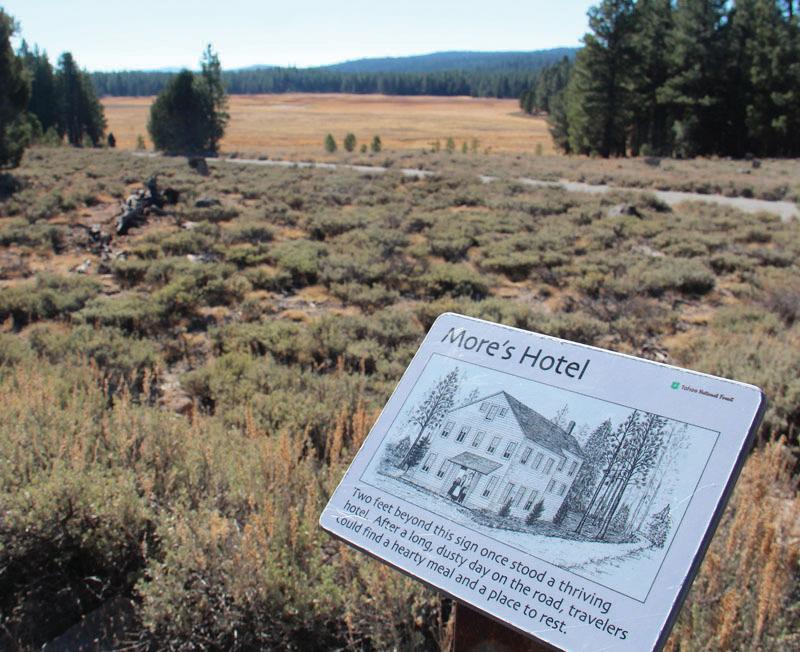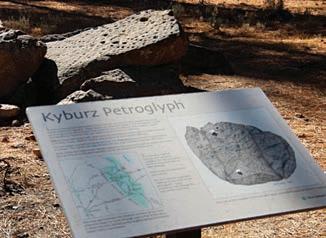
6 minute read
Lake Tahoe Facts
GEToutside
the outdoors | recreation | events | mountain life
Advertisement
Kyburz Flat
EXPLORE PETROGLYPHS, SHEEP CAMP & WAY STATION
STORY & PHOTOS MARK M c LAUGHLIN
Before and during California’s Gold Rush era, a multitude of routes were blazed over the Sierra Nevada into the Golden State. e northern mining district in the Bear, Yuba and Feather River valleys were distant from the main transSierra arteries that utilized the Truckee River route west over the Donner Pass area or the Carson River trail through the mountains south of Lake Tahoe.
In the early 1850s gold seekers discovered a more direct route to the northern mines by cutting away from the Truckee River near present-day Floriston and heading northwest into Dog Valley toward the Little Truckee River. From there miners and wagons crossed a relatively low 6,842foot pass over the Sierra divide into the west- owing Middle Fork of the Yuba River. For years, the Henness Pass Road served as the primary supply route from San Francisco and Sacramento to the Comstock mines in Virginia City, Nev. is historically signi cant road was later included in the Lincoln Highway, the country’s rst transcontinental highway system.
Today, the U.S. Forest Service hosts a cluster of three thought-provoking interpretive sites at Kyburz Flat, about 16 miles north of Truckee on Highway 89 at its intersection with old Henness Pass Road. Kyburz Flat is a peaceful wildlife viewing area with streams and small pools of water depending on the season. It is also part of a protected animal migration corridor.
Once you enter the site, drive to the rst interpretive marker about one mile east of Highway 89. e area reveals a remarkable example of cupule petroglyphs that o er evidence Washoe Indians and their ancestors camped in the area 2,000 years ago. Second, a nearby loop trail traces the remains of More’s Station, a busy way station and hotel for stage passengers and other travelers on Henness Pass Road. And nally, a short distance away, is a fully functioning brick oven used by Basque sheepherders to bake bread and cook stews while they grazed their ocks in the nearby meadows during warm Sierra summers. is informative historical tour takes about an hour to visit all three sites. e large petroglyph at Interpretive Marker 1 is a slab of rock where small round pits (cupules) have been patiently ground into the surface by Native Americans. Some ancient symbols and grinding holes etched in obdurate granite in the Sierra are the work of generations. Petroglyphs are scattered throughout these mountains, but cupules are distinctive and part of traditional ceremonial activities such as fertility rituals and a place to leave special o erings. e Washoe Tribe of Nevada and California considers this area an important heritage site to be treated with respect with no rubbings or castings of the petroglyphs. Photography is allowed.
MORE’S STATION

Next stop is an interpretive path through the remnants of More’s Station, hotel and ranch within a short walk down the road from the petroglyph. After the 1859 discovery of the Comstock Lode, Henness Pass Road was improved to handle the increased tra c of hundreds of food, merchandise and equipment-laden freight wagons, as well as farm buckboards hauling families and their household goods to booming western Nevada. More’s Station was a 320acre spread operated by Lysander More and his family. Much of the trail is on a wooden boardwalk free of the prickly sagebrush, occasional snake and loose rock that characterize this arid landscape.
Illustrated signs indicate the location and functions of the hotel, barn, root cellar, water well and corral. Piled rocks reveal low walls used to anchor fenceposts that kept stock animals safely in the corral, while a shallow pit marks the location of a 40-footdeep well. e well was hand-pumped to deliver potable water to the surface for parched and dusty humans and livestock.
WHEELER SHEEP CAMP
A short drive or 15-minute hike away are the open meadows of the Wheeler Sheep Camp, one of the main grazing areas for the Wheeler Sheep Company based in Reno. is camp was built and managed before 1921 by the Gallues brothers John and Felix. Immigrants from the Basque country in the western Pyrenees Mountains of Spain, the Gallues
TOP: More’s Hotel plaque at Kyburz Flat. LEFT: Cupule petroglyphs.
are part of a rich heritage of Basque ranchers in California and Nevada. e rst wave of Basque nationals were mostly illiterate with little to no experience in sheepherding; they learned on the job working for others.
Initially drawn by the California Gold Rush, Basque ranchers and sheepherders later moved operations to Nevada due to less expensive land and economic booms brought on by a series of precious metal discoveries. A second surge of Basque immigrants at the turn of the 20th Century were not attracted by gold and silver. Most were escaping political and economic turmoil in their home country and seeking a new stable life with steady employment in sheepherding among their transplanted compatriots in the Great Basin. All the buildings built by John and Felix Gallues for the Wheeler Sheep Camp are now gone except for a large brick oven that was rst constructed in 1927. e present version is a restoration completed in 1992. e dome oven is fully operational and may be reserved for use by the public. Contact the Sierraville Ranger Station for permission.
It’s easy to miss the entrance to Kyburz Flat with only a small sign along the roadway. Heading north from Truckee, look for a large chain-linked fence on the right side before you reach Jackson Meadows Road. Turn and follow the dirt road into the protected area to reach the parking area for Kyburz Flat. At the parking area, you’ll nd the petroglyph and the boardwalk nearby. Continue north along a short sideroad to reach Wheeler Sheep Camp, which also has a parking area.
Passenger vehicles are OK to reach the site; traveling any further along Henness Pass Road will require a vehicle that can handle rough conditions, however. ere is a vault toilet at the parking area. | fs.usda.gov
SUBMIT YOUR EVENTS FOR FREE
Visit TheTahoeWeekly.com to add your Event for our print & online calendars.
Click on Events; then the blue Add Event button.
Squaw gondola work to start this summer
Alterra Mountain Company has announced that the Base-to-Base Gondola will begin construction this summer. This base-to-base connection will take skiers and riders between Squaw Valley and Alpine Meadows in about 16 minutes. The Gondola will have eight-passenger cabins and the capacity to move 1,400 people per hour. It will offer access to 6,000 acres of skiing and riding for all skill levels. The $60-million project includes two main terminals, two mid-stations and additional base area improvements targeted to enhance the guest experience.
There will be intermittent closures along the Five Lakes and Western States trails through August. | Updates blog. squawalpine.com
Junior Rangers
program launched
Nevada State Parks has launched a Junior Ranger program. Children of all ages are invited to earn Junior Ranger badges by completing a free activity book during a visit to any or all of Nevada’s state parks. Some activities include creating a sound map, interviewing a park ranger, and identifying scat and animal tracks. The activity book will be available at each state park or can be downloaded from parks.nv.gov.
Kids’ nature activity books available
Tahoe Institute for Natural Science has released a new Tahoe Nature Activity Book. Topics include: “How to Draw a Western Tanager,” “Tahoe’s Rockin’ Geology” and “Tahoe at Night.”








